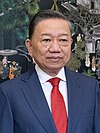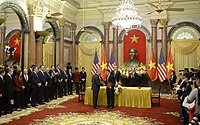
A | B | C | D | E | F | G | H | CH | I | J | K | L | M | N | O | P | Q | R | S | T | U | V | W | X | Y | Z | 0 | 1 | 2 | 3 | 4 | 5 | 6 | 7 | 8 | 9
Socialist Republic of Vietnam Cộng hòa Xã hội chủ nghĩa Việt Nam (Vietnamese) | |
|---|---|
| Motto: Độc lập – Tự do – Hạnh phúc "Independence – Freedom – Happiness" | |
| Anthem: Tiến Quân Ca "Army March" | |
Location of Vietnam (green) in ASEAN (dark grey) | |
| Capital | Hanoi 21°2′N 105°51′E / 21.033°N 105.850°E |
| Largest city | Ho Chi Minh City 10°48′N 106°39′E / 10.800°N 106.650°E |
| Official language | Vietnamese[1] |
| Ethnic groups (2019) |
|
| Religion (2019) |
|
| Demonym(s) | Vietnamese Viet (colloquial) |
| Government | Unitary Marxist–Leninist one-party socialist republic[5] |
| Nguyễn Phú Trọng | |
| Tô Lâm | |
| Phạm Minh Chính | |
| Trần Thanh Mẫn | |
| Legislature | National Assembly |
| Formation | |
• Văn Lang | 7th century BC |
• Âu Lạc | 3th century BC |
| 111 BC | |
| 939 | |
| 1428 | |
• Nguyễn's unification | 1802 |
| 25 August 1883 | |
| 2 September 1945 | |
| 21 July 1954 | |
| 30 April 1975 | |
| 2 July 1976 | |
• Đổi Mới | 18 December 1986 |
| 28 November 2013[b] | |
| Area | |
• Total | 331,344.82[7][c] km2 (127,932.95 sq mi) (66th) |
• Water (%) | 6.38 |
| Population | |
• 2023 estimate | 100,300,000[10][11] (15th) |
• 2019 census | 96,208,984[2] |
• Density | 298/km2 (771.8/sq mi) (49th) |
| GDP (PPP) | 2024 estimate |
• Total | |
• Per capita | |
| GDP (nominal) | 2024 estimate |
• Total | |
• Per capita | |
| Gini (2020) | medium |
| HDI (2022) | high (107th) |
| Currency | Vietnamese đồng (₫) (VND) |
| Time zone | UTC+07:00 (Vietnam Standard Time) |
| Driving side | right |
| Calling code | +84 |
| ISO 3166 code | VN |
| Internet TLD | .vn |
Vietnam,[d][e] officially the Socialist Republic of Vietnam (SRV),[f] is a country at the eastern edge of mainland Southeast Asia, with an area of about 331,000 square kilometres (128,000 sq mi) and a population of over 100 million, making it the world's fifteenth-most populous country. One of the two Marxist-Leninist states in Southeast Asia[g], Vietnam shares land borders with China to the north, and Laos and Cambodia to the west. It shares maritime borders with Thailand through the Gulf of Thailand, and the Philippines, Indonesia, and Malaysia through the South China Sea. Its capital is Hanoi and its largest city is Ho Chi Minh City (commonly known as Saigon).
Vietnam was inhabited by the Paleolithic age, with states established in the first millennium BC on the Red River Delta in modern-day northern Vietnam. The Han dynasty annexed Northern and Central Vietnam under Chinese rule from 111 BC, until the first dynasty emerged in 939. Successive monarchical dynasties absorbed Chinese influences through Confucianism and Buddhism, and expanded southward to the Mekong Delta, conquering Champa. During most of the 17th and 18th centuries, Vietnam was effectively divided into two domains of Đàng Trong and Đàng Ngoài. The Nguyễn—the last imperial dynasty—surrendered to France in 1883. In 1887, its territory was integrated into French Indochina as three separate regions. In the immediate aftermath of World War II, the nationalist coalition Viet Minh, led by the communist revolutionary Ho Chi Minh, launched the August Revolution and declared Vietnam's independence in 1945.
Vietnam went through prolonged warfare in the 20th century. After World War II, France returned to reclaim colonial power in the First Indochina War, from which Vietnam emerged victorious in 1954. As a result of the treaties signed between the Viet Minh and France, Vietnam was also separated into two parts. The Vietnam War began shortly after, between the communist North Vietnam, supported by the Soviet Union and China, and the anti-communist South Vietnam, supported by the United States. Upon the North Vietnamese victory in 1975, Vietnam reunified as a unitary socialist state under the Communist Party of Vietnam (CPV) in 1976. An ineffective planned economy, a trade embargo by the West, and wars with Cambodia and China crippled the country further. In 1986, the CPV initiated economic and political reforms similar to the Chinese economic reform, transforming the country to a socialist-oriented market economy. The reforms facilitated Vietnamese reintegration into the global economy and politics.
Vietnam is a developing country with a lower-middle-income economy. It has high levels of corruption, censorship, environmental issues and a poor human rights record; the country ranks among the lowest in international measurements of civil liberties, freedom of the press, and freedom of religion and ethnic minorities. It is part of international and intergovernmental institutions including the ASEAN, the APEC, the CPTPP, the Non-Aligned Movement, the OIF, and the WTO. It has assumed a seat on the United Nations Security Council twice.
Etymology
The name Việt Nam (Vietnamese pronunciation: [viə̀t naːm], chữ Hán: 越南), literally "Viet South", means "Viet of the South" per Vietnamese word order or "South of the Viet" per Classical Chinese word order.[15] A variation of the name, Nanyue (or Nam Việt, 南越), was first documented in the 2nd century BC.[16] The term "Việt" (Yue) (Chinese: 越; pinyin: Yuè; Cantonese Yale: Yuht; Wade–Giles: Yüeh4; Vietnamese: Việt) in Early Middle Chinese was first written using the logograph "戉" for an axe (a homophone), in oracle bone and bronze inscriptions of the late Shang dynasty (c. 1200 BC), and later as "越".[17] At that time it referred to a people or chieftain to the northwest of the Shang.[18] In the early 8th century BC, a tribe on the middle Yangtze were called the Yangyue, a term later used for peoples further south.[18] Between the 7th and 4th centuries BC Yue/Việt referred to the State of Yue in the lower Yangtze basin and its people.[17][18] From the 3rd century BC the term was used for the non-Chinese populations of southern China and northern Vietnam, with particular ethnic groups called Minyue, Ouyue, Luoyue (Vietnamese: Lạc Việt), etc., collectively called the Baiyue (Bách Việt, Chinese: 百越; pinyin: Bǎiyuè; Cantonese Yale: Baak Yuet; Vietnamese: Bách Việt; "Hundred Yue/Viet").[17][18][19] The term Baiyue/Bách Việt first appeared in the book Lüshi Chunqiu compiled around 239 BC.[20] By the 17th and 18th centuries AD, educated Vietnamese apparently referred to themselves as người Việt (Viet people) or người Nam (southern people).[21]

The form Việt Nam (越南) is first recorded in the 16th-century oracular poem Sấm Trạng Trình. The name has also been found on 12 steles carved in the 16th and 17th centuries, including one at Bao Lam Pagoda in Hải Phòng that dates to 1558.[22] In 1802, Nguyễn Phúc Ánh (who later became Emperor Gia Long) established the Nguyễn dynasty. In the second year of his rule, he asked the Jiaqing Emperor of the Qing dynasty to confer on him the title 'King of Nam Việt / Nanyue' (南越 in Chinese character) after seizing power in Annam. The Emperor refused because the name was related to Zhao Tuo's Nanyue, which included the regions of Guangxi and Guangdong in southern China. The Qing Emperor, therefore, decided to call the area "Việt Nam" instead,[h][24] meaning "South of the Viet" per Classical Chinese word order but the Vietnamese understood it as "Viet of the South" per Vietnamese word order.[15] Between 1804 and 1813, the name Vietnam was used officially by Emperor Gia Long.[h] It was revived in the early 20th century in Phan Bội Châu's History of the Loss of Vietnam, and later by the Vietnamese Nationalist Party (VNQDĐ).[25] The country was usually called Annam until 1945, when the imperial government in Huế adopted Việt Nam.[26]
History
Prehistory and early history
Archaeological excavations have revealed the existence of humans in what is now Vietnam as early as the Paleolithic age. Stone artefacts excavated in Gia Lai province have been claimed to date to 780,000 years ago,[27] based on associated find of tektites, however this claim has been challenged because tektites are often found in archaeological sites of various ages in Vietnam.[28] Homo erectus fossils dating to around 500,000 BC have been found in caves in Lạng Sơn and Nghệ An provinces in northern Vietnam.[29] The oldest Homo sapiens fossils from mainland Southeast Asia are of Middle Pleistocene provenance, and include isolated tooth fragments from Tham Om and Hang Hum.[30][31][32] Teeth attributed to Homo sapiens from the Late Pleistocene have been found at Dong Can,[33] and from the Early Holocene at Mai Da Dieu,[34][35] Lang Gao[36][37] and Lang Cuom.[38] Areas comprising what is now Vietnam participated in the Maritime Jade Road, as ascertained by archeological research.[39][40][41][42]
By about 1,000 BC, the development of wet-rice cultivation in the Ma River and Red River floodplains led to the flourishing of Đông Sơn culture,[43][44] notable for its bronze casting used to make elaborate bronze Đông Sơn drums.[45][46][47] At this point, the early Vietnamese kingdoms of Văn Lang and Âu Lạc appeared, and the culture's influence spread to other parts of Southeast Asia, including Maritime Southeast Asia, throughout the first millennium BC.[46][48]
Dynastic Vietnam
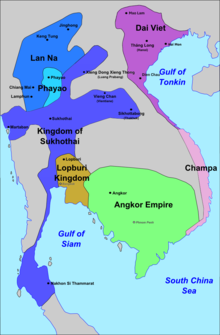
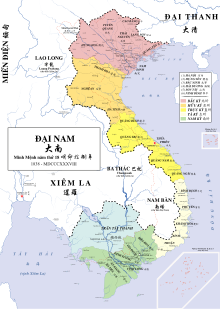
According to Vietnamese legends, Hồng Bàng dynasty of the Hùng kings first established in 2879 BC is considered the first state in the history of Vietnam (then known as Xích Quỷ and later Văn Lang).[49][50] In 257 BC, the last Hùng king was defeated by Thục Phán. He consolidated the Lạc Việt and Âu Việt tribes to form the Âu Lạc, proclaiming himself An Dương Vương.[51] In 179 BC, a Chinese general named Zhao Tuo ("Triệu Đà") defeated An Dương Vương and consolidated Âu Lạc into Nanyue.[44] However, Nanyue was itself incorporated into the empire of the Chinese Han dynasty in 111 BC after the Han–Nanyue War.[24][52] For the next thousand years, what is now northern Vietnam remained mostly under Chinese rule.[53][54] Early independence movements, such as those of the Trưng Sisters and Lady Triệu,[55] were temporarily successful,[56] though the region gained a longer period of independence as Vạn Xuân under the Anterior Lý dynasty between AD 544 and 602.[57][58][59] By the early 10th century, Northern Vietnam had gained autonomy, but not sovereignty, under the Khúc family.[60]
In AD 938, the Vietnamese lord Ngô Quyền defeated the forces of the Chinese Southern Han state at Bạch Đằng River and achieved full independence for Vietnam in 939 after a millennium of Chinese domination.[61][62][63] By the 960s, the dynastic Đại Việt (Great Viet) kingdom was established, Vietnamese society enjoyed a golden era under the Lý and Trần dynasties. During the rule of the Trần Dynasty, Đại Việt repelled three Mongol invasions.[64][65] Meanwhile, the Mahāyāna branch of Buddhism flourished and became the state religion.[63][66] Following the 1406–7 Ming–Hồ War, which overthrew the Hồ dynasty, Vietnamese independence was interrupted briefly by the Chinese Ming dynasty, but was restored by Lê Lợi, the founder of the Lê dynasty.[67] The Vietnamese polity reached their zenith in the Lê dynasty of the 15th century, especially during the reign of emperor Lê Thánh Tông (1460–1497).[68][69] Between the 11th and 18th centuries, the Vietnamese polity expanded southward in a gradual process known as Nam tiến ("Southward expansion"),[70] eventually conquering the kingdom of Champa and part of the Khmer Kingdom.[71][72][73]
From the 16th century onward, civil strife and frequent political infighting engulfed much of Dai Viet. First, the Chinese-supported Mạc dynasty challenged the Lê dynasty's power.[74] After the Mạc dynasty was defeated, the Lê dynasty was nominally reinstalled. Actual power, however, was divided between the northern Trịnh lords and the southern Nguyễn lords, who engaged in a civil war for more than four decades before a truce was called in the 1670s.[75] Vietnam was divided into North (Trịnh) and South (Nguyễn) from 1600 to 1777. During this period, the Nguyễn expanded southern Vietnam into the Mekong Delta, annexing the Central Highlands and the Khmer lands in the Mekong Delta.[71][73][76] The division of the country ended a century later when the Tây Sơn brothers helped Trịnh to end Nguyễn, they also established new dynasty and ended Trịnh. However, their rule did not last long, and they were defeated by the remnants of the Nguyễn lords, led by Nguyễn Ánh. Nguyễn Ánh unified Vietnam, and established the Nguyễn dynasty, ruling under the name Gia Long.[76]
French Indochina
In the 1500s, the Portuguese explored the Vietnamese coast and reportedly erected a stele on the Chàm Islands to mark their presence.[77] By 1533, they began landing in the Vietnamese delta but were forced to leave because of local turmoil and fighting. They also had less interest in the territory than they did in China and Japan.[77] After they had settled in Macau and Nagasaki to begin the profitable Macau–Japan trade route, the Portuguese began to involve themselves in trade with Hội An.[77] Portuguese traders and Jesuit missionaries under the Padroado system were active in both Vietnamese realms of Đàng Trong (Cochinchina or Quinan) and Đàng Ngoài (Tonkin) in the 17th century.[78] The Dutch also tried to establish contact with Quinan in 1601 but failed to sustain a presence there after several violent encounters with the locals. The Dutch East India Company (VOC) only managed to establish official relations with Tonkin in the spring of 1637 after leaving Dejima in Japan to establish trade for silk.[79] Meanwhile, in 1613, the first English attempt to establish contact with Hội An failed following a violent incident involving the East India Company. By 1672 the English did establish relations with Tonkin and were allowed to reside in Phố Hiến.[80]

Between 1615 and 1753, French traders also engaged in trade in Vietnam.[81][82] The first French missionaries arrived in 1658, under the Portuguese Padroado. From its foundation, the Paris Foreign Missions Society under Propaganda Fide actively sent missionaries to Vietnam, entering Cochinchina first in 1664 and Tonkin first in 1666.[83] Spanish Dominicans joined the Tonkin mission in 1676, and Franciscans were in Cochinchina from 1719 to 1834. The Vietnamese authorities began[when?] to feel threatened by continuous Christianisation activities.[84] After several Catholic missionaries were detained, the French Navy intervened in 1843 to free them, as the kingdom was perceived as xenophobic.[85] In a series of conquests from 1859 to 1885, France eroded Vietnam's sovereignty.[86] At the siege of Tourane in 1858, France was aided by Spain (with Filipino, Latin American, and Spanish troops from the Philippines)[87] and perhaps some Tonkinese Catholics.[88] After the 1862 Treaty, and especially after France completely conquered Lower Cochinchina in 1867, the Văn Thân movement of scholar-gentry class arose and committed violence against Catholics across central and northern Vietnam.[89]
Between 1862 and 1867, the southern third of the country became the French colony of Cochinchina.[90] By 1884, the entire country was under French rule, with the central and northern parts of Vietnam separated into the two protectorates of Annam and Tonkin. The three entities were formally integrated into the union of French Indochina in 1887.[91][92] The French administration imposed significant political and cultural changes on Vietnamese society.[93] A Western-style system of modern education introduced new humanist values.[94] Most French settlers in Indochina were concentrated in Cochinchina, particularly in Saigon, and in Hanoi, the colony's capital.[95]
During the colonial period, guerrillas of the royalist Cần Vương movement rebelled against French rule and massacred around a third of Vietnam's Christian population.[96][97] After a decade of resistance, they were defeated in the 1890s by the Catholics in reprisal for their earlier massacres.[98][99] Another large-scale rebellion, the Thái Nguyên uprising, was also suppressed heavily.[100] The French developed a plantation economy to promote export of tobacco, indigo, tea and coffee.[101] However, they largely ignored the increasing demands for civil rights and self-government. An increasing dissatisfaction, even led to half-hearted, badly co-ordinated, and still worsely executed plots to oust the French, like the infamous Hanoi Poison Plot of 1908.
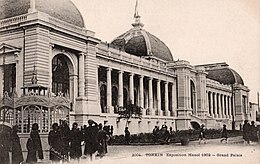
A nationalist political movement soon emerged, with leaders like Phan Bội Châu, Phan Châu Trinh, Phan Đình Phùng, Emperor Hàm Nghi, and Hồ Chí Minh fighting or calling for independence.[102] This resulted in the 1930 Yên Bái mutiny by the Vietnamese Nationalist Party (VNQDĐ), which the French quashed. The mutiny split the independence movement, as many leading members converted to communism.[103][104][105]
The French maintained full control of their colonies until World War II, when the war in the Pacific led to the Japanese invasion of French Indochina in 1940. Afterwards, the Japanese Empire was allowed to station its troops in Vietnam while the pro-Vichy French colonial administration continued.[106][107] Japan exploited Vietnam's natural resources to support its military campaigns, culminating in a full-scale takeover of the country in March 1945. This led to the Vietnamese Famine of 1945 which killed up to two million people.[108][109]
First Indochina War
In 1941, the Việt Minh, a nationalist liberation movement based on a communist ideology, emerged under the Vietnamese revolutionary leader Hồ Chí Minh. The Việt Minh sought independence for Vietnam from France and the end of the Japanese occupation.[110][111] After the military defeat of Japan in World War II and the fall of its puppet government Empire of Vietnam in August 1945, Saigon's administrative services collapsed and chaos, riots, and murder were widespread.[112] The Việt Minh occupied Hanoi and proclaimed a provisional government, which asserted national independence on 2 September.[111]
In July 1945, the Allies had decided to divide Indochina at the 16th parallel to allow Chiang Kai-shek of the Republic of China to receive the Japanese surrender in the north while Britain's Lord Louis Mountbatten received their surrender in the south. The Allies agreed that Indochina still belonged to France.[113][114]
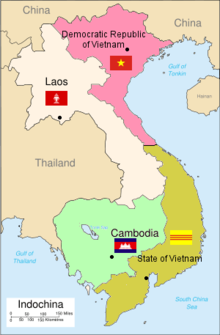
But as the French were weakened by the German occupation, British-Indian forces and the remaining Japanese Southern Expeditionary Army Group were used to maintain order and help France reestablish control through the 1945–1946 War in Vietnam.[115] Hồ initially chose to take a moderate stance to avoid military conflict with France, asking the French to withdraw their colonial administrators and for French professors and engineers to help build a modern independent Vietnam.[111] But the Provisional Government of the French Republic did not act on these requests, including the idea of independence, and dispatched the French Far East Expeditionary Corps to restore colonial rule. This resulted in the Việt Minh launching a guerrilla campaign against the French in late 1946.[110][111][116] The resulting First Indochina War lasted until July 1954. The defeat of French colonialists and Vietnamese loyalists in the 1954 battle of Điện Biên Phủ allowed Hồ to negotiate a ceasefire from a favourable position at the subsequent Geneva Conference.[111][117]
The colonial administration was thereby ended and French Indochina was dissolved under the Geneva Accords of 21 July 1954 into three countries—Vietnam, and the kingdoms of Cambodia and Laos. Vietnam was further divided into North and South administrative regions at the Demilitarised Zone, roughly along the 17th parallel north (pending elections scheduled for July 1956[i]). A 300-day period of free movement was permitted, during which almost a million northerners, mainly Catholics, moved south, fearing persecution by the communists. This migration was in large part aided by the United States military through Operation Passage to Freedom.[122][123] The partition of Vietnam by the Geneva Accords was not intended to be permanent, and stipulated that Vietnam would be reunited after the elections.[124] But in 1955, the southern State of Vietnam's prime minister, Ngô Đình Diệm, toppled Bảo Đại in a fraudulent referendum organised by his brother Ngô Đình Nhu, and proclaimed himself president of the Republic of Vietnam.[124] This effectively replaced the internationally recognised State of Vietnam by the Republic of Vietnam in the south—supported by the United States, France, Laos, Republic of China and Thailand—and Hồ's Democratic Republic of Vietnam in the north, supported by the Soviet Union, Sweden,[125] Khmer Rouge, and the People's Republic of China.[124]
Vietnam War
From 1953 to 1956, the North Vietnamese government instituted agrarian reforms including "rent reduction" and "land reform", which resulted in significant political repression.[126] This included 13,500 to as many as 100,000 executions.[127][128] In the South, Diệm countered North Vietnamese subversion (including the assassination of over 450 South Vietnamese officials in 1956) by detaining tens of thousands of suspected communists in "political reeducation centres".[129][130] This program incarcerated many non-communists, but was successful at curtailing communist activity in the country, if only for a time.[131] The North Vietnamese government claimed that 2,148 people were killed in the process by November 1957.[132] The pro-Hanoi Việt Cộng began a guerrilla campaign in South Vietnam in the late 1950s to overthrow Diệm's government.[133] From 1960, the Soviet Union and North Vietnam signed treaties providing for further Soviet military support.[134][135][136]
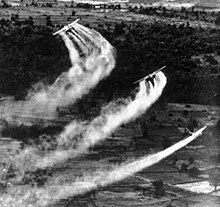
In 1963, Buddhist discontent with Diệm's Catholic regime erupted into mass demonstrations, leading to a violent government crackdown.[137] This led to the collapse of Diệm's relationship with the United States, and ultimately to a 1963 coup in which he and Nhu were assassinated.[138] The Diệm era was followed by more than a dozen successive military governments, before the pairing of Air Marshal Nguyễn Cao Kỳ and General Nguyễn Văn Thiệu took control in mid-1965.[139] Thiệu gradually outmaneuvered Kỳ and cemented his grip on power in fraudulent elections in 1967 and 1971.[140] During this political instability, the communists began to gain ground. To support South Vietnam's struggle against the communist insurgency, the United States used the 1964 Gulf of Tonkin incident as a pretext for increasing its contribution of military advisers.[141] US forces became involved in ground combat operations by 1965, and at their peak several years later, numbered more than 500,000.[142][143] The US also engaged in sustained aerial bombing. Meanwhile, China and the Soviet Union provided North Vietnam with significant material aid and 15,000 combat advisers.[134][135][144] Communist forces supplying the Việt Cộng carried supplies along the Hồ Chí Minh trail, which passed through Laos.[145]
The communists attacked South Vietnamese targets during the 1968 Tết Offensive. The campaign failed militarily, but shocked the American establishment and turned US public opinion against the war.[146] During the offensive, communist troops massacred over 3,000 civilians at Huế.[147][148] Facing an increasing casualty count, rising domestic opposition to the war, and growing international condemnation, the US began withdrawing from ground combat roles in the early 1970s. This also entailed an unsuccessful effort to strengthen and stabilise South Vietnam.[149] Following the Paris Peace Accords of 27 January 1973, all American combat troops were withdrawn by 29 March 1973.[150] In December 1974, North Vietnam captured the province of Phước Long and started a full-scale offensive, culminating in the fall of Saigon on 30 April 1975.[151] South Vietnam was ruled by a provisional government for almost eight years while under North Vietnamese military occupation.[152]
Reunification and reforms
On 2 July 1976, North and South Vietnam were merged to form the Socialist Republic of Vietnam.[153] The war had devastated Vietnam and killed 966,000 to 3.8 million people.[154][155][156] A 1974 US Senate subcommittee estimated nearly 1.4 million Vietnamese civilians were killed or wounded between 1965 and 1974—including 415,000 killed.[157][158] In its aftermath, under Lê Duẩn's administration, there were no mass executions of South Vietnamese who had collaborated with the US or the defunct South Vietnamese government, confounding Western fears,[159] but up to 300,000 South Vietnamese were sent to reeducation camps, where many endured torture, starvation, and disease while being forced to perform hard labour.[160] The government embarked on a mass campaign of collectivisation of farms and factories.[161] Many fled the country following the conclusion of the war.[162] In 1978, in response to the Khmer Rouge government of Cambodia ordering massacres of Vietnamese residents in the border villages in the districts of An Giang and Kiên Giang,[163] the Vietnamese military invaded Cambodia and removed them from power after occupying Phnom Penh.[164] The intervention was a success, resulting in the establishment of a new, pro-Vietnam socialist government, the People's Republic of Kampuchea, which ruled until 1989.[165] However, this worsened relations with China, which had supported the Khmer Rouge. China later launched a brief incursion into northern Vietnam in 1979, causing Vietnam to rely even more heavily on Soviet economic and military aid, while mistrust of the Chinese government escalated.[166]
At the Sixth National Congress of the Communist Party of Vietnam (CPV) in December 1986, reformist politicians replaced the "old guard" government with new leadership.[167][168] The reformers were led by 71-year-old Nguyễn Văn Linh, who became the party's new general secretary.[167] He and the reformers implemented a series of free-market reforms known as Đổi Mới ("Renovation") that carefully managed the transition from a planned economy to a "socialist-oriented market economy".[169][170] Although the authority of the state remained unchallenged under Đổi Mới, the government encouraged private ownership of farms and factories, economic deregulation, and foreign investment, while maintaining control over strategic industries.[170][171] Subsequently, Vietnam's economy achieved strong growth in agricultural and industrial production, construction, exports, and foreign investment, although these reforms also resulted in a rise in income inequality and gender disparities.[172][173][174]
In 2021, General Secretary of the Communist Party, Nguyen Phu Trong, was re-elected for his third term in office, meaning he is Vietnam's most powerful leader in decades.[175]
Geography
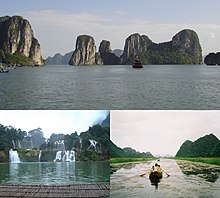
Vietnam is located on the eastern Indochinese Peninsula between the latitudes 8° and 24°N, and the longitudes 102° and 110°E. It covers a total area of 331,210 km2 (127,881 sq mi)[176] or 331,699 km2 (128,070 sq mi).[177] The combined length of the country's land boundaries is 4,639 km (2,883 mi), and its coastline is 3,444 km (2,140 mi) long.[178] At its narrowest point in the central Quảng Bình Province, the country is as little as 50 kilometres (31 mi) across, though it widens to around 600 kilometres (370 mi) in the north.[179] Vietnam's land is mostly hilly and densely forested, with level land covering no more than 20%. Mountains account for 40% of the country's land area,[180] and tropical forests cover around 42%.[181] The Red River Delta in the north, a flat, roughly triangular region covering 15,000 km2 (5,792 sq mi),[182] is smaller but more intensely developed and more densely populated than the Mekong River Delta in the south. Once an inlet of the Gulf of Tonkin, it has been filled in over the millennia by riverine alluvial deposits.[183][184] The delta, covering about 40,000 km2 (15,444 sq mi), is a low-level plain no more than 3 metres (9.8 ft) above sea level at any point. It is criss-crossed by a maze of rivers and canals, which carry so much sediment that the delta advances 60 to 80 metres (196.9 to 262.5 ft) into the sea every year.[185][186] The exclusive economic zone of Vietnam covers 417,663 km2 (161,261 sq mi) in the South China Sea.[187]

Southern Vietnam is divided into coastal lowlands, the mountains of the Annamite Range, and extensive forests. Comprising five relatively flat plateaus of basalt soil, the highlands account for 16% of the country's arable land and 22% of its total forested land.[188] The soil in much of the southern part of Vietnam is relatively low in nutrients as a result of intense cultivation.[189] Several minor earthquakes have been recorded.[190][191] The northern part of the country consists mostly of highlands and the Red River Delta. Fansipan (also known as Phan Xi Păng), which is located in Lào Cai Province, is the highest mountain in Vietnam, standing 3,143 m (10,312 ft) high.[192] From north to south Vietnam, the country also has numerous islands; Phú Quốc is the largest.[193] The Hang Sơn Đoòng Cave is considered the largest known cave passage in the world since its discovery in 2009. The Ba Bể Lake and Mekong River are the largest lake and longest river in the country.[194][195][196]
Climate


Due to differences in latitude and the marked variety in topographical relief, Vietnam's climate tends to vary considerably for each region.[197] During the winter or dry season, extending roughly from November to April, the monsoon winds usually blow from the northeast along the Chinese coast and across the Gulf of Tonkin, picking up considerable moisture.[198] The average annual temperature is generally higher in the plains than in the mountains, especially in southern Vietnam compared to the north. Temperatures vary less in the southern plains around Ho Chi Minh City and the Mekong Delta, ranging from between 21 and 35 °C (70 and 95 °F) over the year.[199] In Hanoi and the surrounding areas of the Red River Delta, the temperatures are much lower between 15 and 33 °C (59 and 91 °F).[199] Seasonal variations in the mountains, plateaus, and the northernmost areas are much more dramatic, with temperatures varying from 3 °C (37 °F) in December and January to 37 °C (99 °F) in July and August.[200] During winter, snow occasionally falls over the highest peaks of the far northern mountains near the Chinese border.[201] Vietnam receives high rates of precipitation in the form of rainfall with an average amount from 1,500 to 2,000 mm (60 to 80 in) during the monsoon seasons; this often causes flooding, especially in the cities with poor drainage systems.[202] The country is also affected by tropical depressions, tropical storms and typhoons.[202] Vietnam is one of the most vulnerable countries to climate change, with 55% of its population living in low-elevation coastal areas.[203][204]
Biodiversity
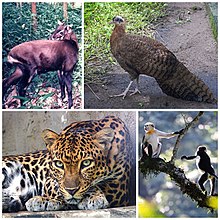
As the country is located within the Indomalayan realm, Vietnam is one of twenty-five countries considered to possess a uniquely high level of biodiversity. This was noted in the country's National Environmental Condition Report in 2005.[205] It is ranked 16th worldwide in biological diversity, being home to approximately 16% of the world's species. 15,986 species of flora have been identified in the country, of which 10% are endemic. Vietnam's fauna includes 307 nematode species, 200 oligochaeta, 145 acarina, 113 springtails, 7,750 insects, 260 reptiles, and 120 amphibians. There are 840 birds and 310 mammals are found in Vietnam, of which 100 birds and 78 mammals are endemic.[205] Vietnam has two World Natural Heritage Sites—the Hạ Long Bay and Phong Nha-Kẻ Bàng National Park—together with nine biosphere reserves, including Cần Giờ Mangrove Forest, Cát Tiên, Cát Bà, Kiên Giang, the Red River Delta, Mekong Delta, Western Nghệ An, Cà Mau, and Cu Lao Cham Marine Park.[206][207][208]
Vietnam is also home to 1,438 species of freshwater microalgae, constituting 9.6% of all microalgae species, as well as 794 aquatic invertebrates and 2,458 species of sea fish.[205] In recent years, 13 genera, 222 species, and 30 taxa of flora have been newly described in Vietnam.[205] Six new mammal species, including the saola, giant muntjac and Tonkin snub-nosed monkey have also been discovered, along with one new bird species, the endangered Edwards's pheasant.[209] In the late 1980s, a small population of Javan rhinoceros was found in Cát Tiên National Park. However, the last individual of the species in Vietnam was reportedly shot in 2010.[210] In agricultural genetic diversity, Vietnam is one of the world's twelve original cultivar centres. The Vietnam National Cultivar Gene Bank preserves 12,300 cultivars of 115 species.[205] The Vietnamese government spent US$49.07 million on the preservation of biodiversity in 2004 alone and has established 126 conservation areas, including 30 national parks.[205]

In Vietnam, wildlife poaching has become a major concern. In 2000, a non-governmental organisation (NGO) called Education for Nature – Vietnam was founded to instill in the population the importance of wildlife conservation in the country.[211] In the years that followed, another NGO called GreenViet was formed by Vietnamese youngsters for the enforcement of wildlife protection. Through collaboration between the NGOs and local authorities, many local poaching syndicates were crippled by their leaders' arrests.[211] A study released in 2018 revealed Vietnam is a destination for the illegal export of rhinoceros horns from South Africa due to the demand for them as a medicine and a status symbol.[212][213]
The main environmental concern that persists in Vietnam today is the legacy of the use of the chemical herbicide Agent Orange, which continues to cause birth defects and many health problems in the Vietnamese population. In the southern and central areas affected most by the chemical's use during the Vietnam War, nearly 4.8 million Vietnamese people have been exposed to it and suffered from its effects.[214][215][216] In 2012, approximately 50 years after the war,[217] the US began a US$43 million joint clean-up project in the former chemical storage areas in Vietnam to take place in stages.[215][218] Following the completion of the first phase in Đà Nẵng in late 2017,[219] the US announced its commitment to clean other sites, especially in the heavily impacted site of Biên Hòa.[220]
The Vietnamese government spends over VNĐ10 trillion each year ($431.1 million) for monthly allowances and the physical rehabilitation of victims of the chemicals.[221] In 2018, the Japanese engineering group Shimizu Corporation, working with Vietnamese military, built a plant for the treatment of soil polluted by Agent Orange. Plant construction costs were funded by the company itself.[222][223] One of the long-term plans to restore southern Vietnam's damaged ecosystems is through the use of reforestation efforts. The Vietnamese government began doing this at the end of the war. It started by replanting mangrove forests in the Mekong Delta regions and in Cần Giờ outside Hồ Chí Minh City, where mangroves are important to ease (though not eliminate) flood conditions during monsoon seasons.[224] The country had a 2019 Forest Landscape Integrity Index mean score of 5.35/10, ranking it 104th globally out of 172 countries.[225]
Apart from herbicide problems, arsenic in the ground water in the Mekong and Red River Deltas has also become a major concern.[226][227] And most notoriously, unexploded ordnances (UXO) pose dangers to humans and wildlife—another bitter legacy from the long wars.[228] As part of the continuous campaign to demine/remove UXOs, several international bomb removal agencies from the United Kingdom,[229] Denmark,[230] South Korea[231] and the US[232] have been providing assistance. The Vietnam government spends over VNĐ1 trillion ($44 million) annually on demining operations and additional hundreds of billions of đồng for treatment, assistance, rehabilitation, vocational training and resettlement of the victims of UXOs.[233]
Government and politics
Vietnam is a unitary Marxist-Leninist one-party socialist republic, one of the two communist states (the other being Laos) in Southeast Asia.[234] Although Vietnam remains officially committed to socialism as its defining creed, its economic policies have grown increasingly capitalist,[235][236] with The Economist characterising its leadership as "ardently capitalist communists".[237] Under the constitution, the Communist Party of Vietnam (CPV) asserts their role in all branches of the country's politics and society.[234] The president is the elected head of state and the commander-in-chief of the military, serving as the chairman of the Council of Supreme Defence and Security, and holds the second highest office in Vietnam as well as performing executive functions and state appointments and setting policy.[234]
The general secretary of the CPV performs numerous key administrative functions, controlling the party's national organisation.[234] The prime minister is the head of government, presiding over a council of ministers composed of five deputy prime ministers and the heads of 26 ministries and commissions. Only political organisations affiliated with or endorsed by the CPV are permitted to contest elections in Vietnam. These include the Vietnamese Fatherland Front and worker and trade unionist parties.[234]
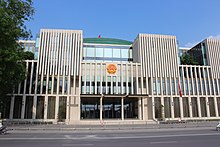
The National Assembly of Vietnam is the unicameral state legislature composed of 500 members.[238] Headed by a chairman, it is superior to both the executive and judicial branches, with all government ministers being appointed from members of the National Assembly.[234] The Supreme People's Court of Vietnam, headed by a chief justice, is the country's highest court of appeal, though it is also answerable to the National Assembly. Beneath the Supreme People's Court stand the provincial municipal courts and many local courts. Military courts possess special jurisdiction in matters of state security. Vietnam maintains the death penalty for numerous offences.[239]
In 2023, a three-person collective leadership was responsible for governing Vietnam. President Võ Văn Thưởng,[240] Prime Minister Phạm Minh Chính (since 2021)[241] and the most powerful leader Nguyễn Phú Trọng (since 2011) as the Communist Party of Vietnam's General Secretary.[242] On 22 May 2024, Tô Lâm, who previously served as the Minister of Public Security, was voted as the president of Vietnam by the National Assembly after Võ Văn Thưởng resigned on the same year due to corruption charges against him.[243]
Foreign relations
Throughout its history, Vietnam's main foreign relationship has been with various Chinese dynasties.[244] Following the partition of Vietnam in 1954, North Vietnam maintained relations with the Eastern Bloc, South Vietnam maintained relations with the Western Bloc.[244] Despite these differences, Vietnam's sovereign principles and insistence on cultural independence have been laid down in numerous documents over the centuries before its independence. These include the 11th-century patriotic poem "Nam quốc sơn hà" and the 1428 proclamation of independence "Bình Ngô đại cáo". Though China and Vietnam are now formally at peace,[244] significant territorial tensions remain between the two countries over the South China Sea.[245] Vietnam holds membership in 63 international organisations, including the United Nations (UN), Association of Southeast Asian Nations (ASEAN), Non-Aligned Movement (NAM), International Organisation of the Francophonie (La Francophonie), and World Trade Organization (WTO). It also maintains relations with over 650 non-governmental organisations.[246] As of 2010 Vietnam had established diplomatic relations with 178 countries.[247]
Vietnam's current foreign policy is to consistently implement a policy of independence, self-reliance, peace, co-operation, and development, as well openness, diversification, multilateralisation with international relations.[248][249] The country declares itself a friend and partner of all countries in the international community, regardless of their political affiliation, by actively taking part in international and regional cooperative development projects.[170][248] Since the 1990s, Vietnam has taken several key steps to restore diplomatic ties with capitalist Western countries. It already had relations with communist Western countries in the decades prior.[250] Relations with the United States began improving in August 1995 with both states upgrading their liaison offices to embassy status.[251] As diplomatic ties between the two governments grew, the United States opened a consulate general in Ho Chi Minh City while Vietnam opened its consulate in San Francisco. Full diplomatic relations were also restored with New Zealand, which opened its embassy in Hanoi in 1995;[252] Vietnam established an embassy in Wellington in 2003.[253] President of the United States, Bill Clinton, made a historic visit to Vietnam in November 2000. He was the first U.S. leader ever to officially visit Hanoi and the first to visit Vietnam since U.S. troops withdrew from the country in 1975.[254] Pakistan also reopened its embassy in Hanoi in October 2000, with Vietnam reopening its embassy in Islamabad in December 2005 and trade office in Karachi in November 2005.[255][256] In May 2016, US President Barack Obama further normalised relations with Vietnam after he announced the lifting of an arms embargo on sales of lethal arms to Vietnam.[257] Despite their historical past, today Vietnam is considered to be a potential ally of the United States, especially in the geopolitical context of the territorial disputes in the South China Sea and in containment of Chinese expansionism.[258][259][260]
Military
The Vietnam People's Armed Forces consists of the Vietnam People's Army (VPA), the Vietnam People's Public Security and the Vietnam Self-Defence Militia. The VPA is the official name for the active military services of Vietnam, and is subdivided into the Vietnam People's Ground Forces, the Vietnam People's Navy, the Vietnam People's Air Force, the Vietnam Border Guard and the Vietnam Coast Guard. The VPA has an active manpower of around 450,000, but its total strength, including paramilitary forces, may be as high as 5,000,000.[261] In 2015, Vietnam's military expenditure totalled approximately US$4.4 billion, equivalent to around 8% of its total government spending.[262] Joint military exercises and war games have been held with Brunei,[263] India,[264] Japan,[265] Laos,[266] Russia,[267] Singapore[263] and the US.[268] In 2017, Vietnam signed the UN treaty on the Prohibition of Nuclear Weapons.[269][270]
Human rights and sociopolitical issues
Under the current constitution, the CPV is the only party allowed to rule, the operation of all other political parties being outlawed. Other human rights issues concern freedom of association, freedom of speech, freedom of religion, and freedom of the press. In 2009, Vietnamese lawyer Lê Công Định was arrested and charged with the capital crime of subversion; several of his associates were also arrested.[271][272] Amnesty International described him and his arrested associates as prisoners of conscience.[271] Vietnam has also suffered from human trafficking and related issues.[273][274][275]
Administrative divisions
Vietnam is divided into 58 provinces (Vietnamese: Tỉnh, chữ Hán: 省).[276] There are also five municipalities (thành phố trực thuộc trung ương), which are administratively on the same level as provinces.







